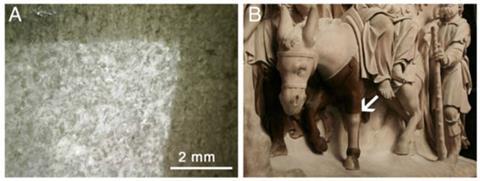
Usually, stone cleaning methods – often involving mechanical or chemical procedures – are a trade-off between removing unwanted deposits that can be harmful to the stone while avoiding damage to the stone itself in the cleaning process.
Now, Davide Gulotta and colleagues at the Polytechnic University of Milan together with conservators at Aconerre, a restoration company in Milan, have demonstrated that agar gel effectively removes soot and salt from historical stone – specifically in the Duomo of Milan – while being safe, quick and easy to use.
Agar gel – comprising a water-soluble polysaccharide extracted from several genera of red seaweeds – has been previously used for cleaning purposes on a small scale, including paintings, wood, stones, plaster, paper and textiles. However, Gulotta says this is the first large-scale systematic on-site evaluation of the entire cleaning procedure, from the preliminary set-up to the final application and presents a green and low-time consuming alternative to current methods.
What's more, the team showed it is possible to tailor the gel with additives – including surfactant and chelating agents – to make it effective against the pH conditions and specific properties of the unwanted deposits. For the Duomo deposits they created a gel suitable for the high content of soluble salts – mostly nitrates and sulfates – which stick strongly to the stone.
Gulotta explains that the agar gel works so well because it has a well-ordered microstructure with a high number of pores that are evenly distributed, which enhance water retention and allow liquid water migration within the gel.
When agar is applied as a water-based poultice, the solvent effect of water is promoted: in the presence of soluble deposits the dissolution is favoured and the dissolved material is drained into the gel structure, effectively soaking it up like sponge.

Unlike other techniques, agar gel adheres well to stone and it can be brushed on which means it can be easily used on sculpted and irregular surfaces, even on vertical or highly inclined substrates. Moreover, the gel can be applied to a specific area, leaving the surrounding ones completely untreated and its transparency means the procedure can be monitored at all times before removing the gel.
'The ability to remove damaging materials such as soluble salts, which can repeatedly recrystallise, and soot, which provides catalytic surfaces and discolours, without damaging the original surface is highly prized,' comments Trevor Brown, a heritage conservation expert at the University of Derby, UK. 'The safety of the poultice, enabling it to be used in the presence of visitors, is a great advantage – in fact tourists may even be attracted to see the ongoing conservation work.'







No comments yet